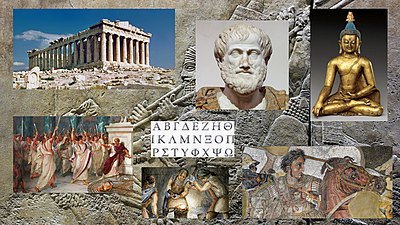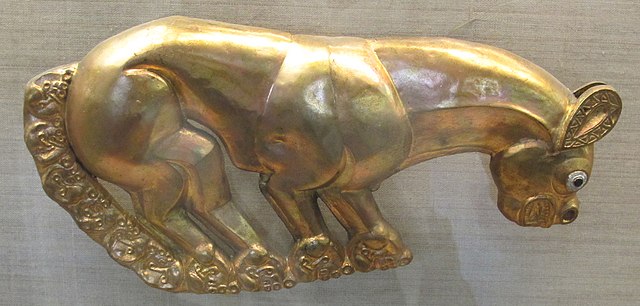Loading AI tools
Millennium between 1000 BC and 1 BC From Wikipedia, the free encyclopedia
The 1st millennium BC, also known as the last millennium BC, was the period of time lasting from the years 1000 BC to 1 BC (10th to 1st centuries BC; in astronomy: JD 1356182.5 – 1721425.5[1]). It encompasses the Iron Age in the Old World and sees the transition from the Ancient Near East to classical antiquity.

World population roughly doubled over the course of the millennium, from about 100 million to about 200–250 million.[2]
The Neo-Assyrian Empire dominates the Near East in the early centuries of the millennium, supplanted by the Achaemenid Empire in the 6th century. Ancient Egypt is in decline, and falls to the Achaemenids in 525 BC.
In Greece, Classical Antiquity begins with the colonization of Magna Graecia and peaks with the conquest of the Achaemenids and the subsequent flourishing of Hellenistic civilization (4th to 2nd centuries).
The Roman Republic supplants the Etruscans and then the Carthaginians (5th to 3rd centuries). The close of the millennium sees the rise of the Roman Empire. The early Celtic culture dominate Central Europe while Northern Europe is in the Pre-Roman Iron Age. In East Africa, the Nubian Empire and Aksum arise.
In South Asia, the Vedic civilization gives rise to the Maurya Empire. The Scythians dominate Central Asia. In China, the Zhou dynasty rules the Chinese heartland at the beginning of the millennium. The decline of the Zhou dynasty during Spring and Autumn period and the Warring States period sees the rise of such philosophical and spiritual traditions as Confucianism and Taoism. Towards the close of the millennium, the Han dynasty extends Chinese power towards Central Asia, where it borders on Indo-Greek and Iranian states. Japan is in the Yayoi period.
The Olmec civilization declines, and the Maya and Zapotec civilizations emerge in Mesoamerica. The Chavín culture flourishes in Peru.
The first millennium BC is the formative period of the classical world religions, with the development of early Judaism and Zoroastrianism in the Near East, and Vedic religion and Vedanta, Jainism and Buddhism in India. Early literature develops in Greek, Latin, Hebrew, Sanskrit, Tamil and Chinese. The term Axial Age, coined by Karl Jaspers, is intended to express the crucial importance of the period of c. the 8th to 2nd centuries BC in world history.
World population more than doubled over the course of the millennium, from about an estimated 50–100 million to an estimated 170–300 million. Close to 90% of world population at the end of the first millennium BC lived in the Iron Age civilizations of the Old World (Roman Empire, Parthian Empire, Graeco-Indo-Scythian and Hindu kingdoms, Han China). The population of the Americas was below 20 million, concentrated in Mesoamerica (Epi-Olmec culture); that of Sub-Saharan Africa was likely below 10 million. The population of Oceania was likely less than one million people.[2]










Archaic period
Classical period
Hellenistic to Roman period
| Culture | Region | Period | Notes |
|---|---|---|---|
| Urnfield culture | Europe, Central | 1300–750 BC | Bronze Age Europe |
| Atlantic Bronze Age | Europe, Western | 1300–700 BC | Bronze Age Europe |
| Painted Grey Ware culture | South Asia | 1200–600 BC | Bronze Age India, Indo-Aryan migration |
| Late Nordic Bronze Age | Europe, North | 1100–550 BC | Bronze Age Europe |
| Villanovan culture | Europe, Italy | 1100–700 BC | Iron Age Europe |
| Greek Dark Ages | Greece | 1100–800 BC | Dorian invasion |
| Iron Age II | Near East | 1000–586 BC | Ancient Near East, List of archaeological periods (Levant) |
| Sa Huỳnh culture | Southeast Asia, Vietnam | 1000 BC–AD 200 | |
| Woodland period | North America | 1000 BC – AD 1000 | List of archaeological periods (North America) |
| Bantu expansion | Sub-Saharan Africa | 1000 BC–AD 500 | |
| Middle Nok Period | Sub-Saharan Africa, West | 900–300 BC | Iron metallurgy in Africa |
| Novocherkassk culture | Europe, Eastern | 900–650 BC | |
| Chavín de Huántar | South America, Peru[7] | 1200–500 BC | |
| Poverty Point earthworks | North America, Louisiana | 1650–700 BC[7] | |
| Olmecs | Mesoamerica | 1500–400 BC | |
| Adena culture | North America, Ohio | 1000–200 BC[7] | |
| Liaoning bronze dagger culture | East Asia | 800–600 BC | |
| Middle Mumun | East Asia, Korea | 800–300 BC | |
| Etruscan civilization | Europe, Italy | 800–264 BC | |
| Paracas culture | South America, Peru | 800–100 BC[7] | |
| Hallstatt culture | Europe, Central | 800 BC–500 BC | Iron Age Europe, Thraco-Cimmerian, Celts |
| British Iron Age | Europe, Britain | 700–50 BC | Insular Celts |
| Zapotec civilization | Mesoamerica | 700 BC – AD 700 | |
| Pazyryk culture | Central Asia | 600–300 BC | Scythians, Saka, Pazyryk burials |
| Aldy-Bel culture | Central Asia | 600–300 BC | Scythians, Saka |
| La Tène culture | Europe, Central/Western | 500–50 BC | Gauls |
| Pre-Roman Iron Age | Europe, North | 500–50 BC | Proto-Germanic |
| Northern Black Polished Ware | South Asia | 500–300 BC | Vedic period |
| Late Mumun | East Asia, Korea | 550–300 BC | |
| Urewe | Sub-Saharan Africa | 400 BC–AD 500 | Iron metallurgy in Africa |
| Late Nok Period | Sub-Saharan Africa, West | 300–1 BC | Iron metallurgy in Africa |
| Nasca culture | South America, Peru | 100 BC–800 AD[7] | |
| Calima culture | South America, Colombia | 200 BC–400 AD | |
| Hopewell tradition | North America | 100 BC–AD 400[8] | |
| Teotihuacan | Mesoamerica | 100 BC –AD 550[8] | |
| Ipiutak site | North America, Alaska | 100 BC –AD 800[8] |
| Year
(BC) |
Date | Eclipse
Type |
Saros
Series |
Eclipse
Magnitude |
Gamma | Ecliptic
Conjunction (UT) |
Greatest
Eclipse (UT) |
Duration
(Min & Sec) |
Description |
|---|---|---|---|---|---|---|---|---|---|
| 899 | 21 Apr | Annular | 53 | 0.9591 | 0.8964 | 22:32:15 | 22:21:56 | 00:03:04 | China's 'Double-Dawn' Eclipse |
| 763 | 15 Jun | Total | 44 | 1.0596 | 0.2715 | 08:11:13 | 08:14:01 | 00:05:00 | Assyrian Eclipse |
| 648 | 6 Apr | Total | 38 | 1.0689 | 0.6898 | 08:24:05 | 08:31:03 | 00:05:02 | Archilochus' Eclipse |
| 585 | 28 May | Total | 57 | 1.0798 | 0.3201 | 14:25:41 | 14:22:26 | 00:06:04 | Thales Eclipse (Medes vs. Lydians), firstly recorded in Herodotus History. |
| 557 | 19 May | Total | 48 | 1.0258 | 0.3145 | 12:49:02 | 12:52:26 | 00:02:22 | The Siege of Larisa, firstly recorded by Xenophon. |
| 480 | 2 Oct | Annular | 65 | 0.9324 | 0.4951 | 11:56:54 | 11:51:01 | 00:07:57 | Xerxes' Eclipse. recorded by Herodotus History. |
| 431 | 3 Aug | Annular | 48 | 0.9843 | 0.8388 | 14:45:34 | 14:54:52 | 00:01:05 | Peloponnesian War. |
| 424 | 21 Mar | Annular | 42 | 0.9430 | 0.9433 | 07:43:30 | 07:54:29 | 00:04:39 | 8th Year of Peloponnesian War. |
Seamless Wikipedia browsing. On steroids.
Every time you click a link to Wikipedia, Wiktionary or Wikiquote in your browser's search results, it will show the modern Wikiwand interface.
Wikiwand extension is a five stars, simple, with minimum permission required to keep your browsing private, safe and transparent.